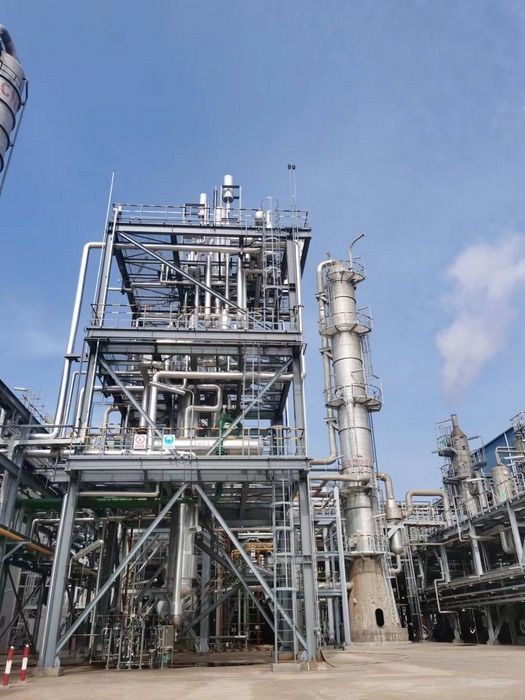High-efficiency CO2 consumption makes it easier to lower the atmospheric concentration of CO2 and, as a result, lessen the greenhouse impact.
 The “CO2 Hydrogenation to Methanol Demonstration Plant” of CNOOC Fudao Ltd. in Dongfang City, Hainan Province, China. This plant has a methanol production capacity of more than 5,000 tons/year using the layered double hydroxides derived Cu-based catalyst developed by Shanghai Advanced Research Institute, Chinese Academy of Sciences. They were also developing the industrial technology of CO2 hydrogenation to lower olefins, aromatics, gasoline, jet fuel-range hydrocarbons, etc. Image Credit: Chinese Journal of Catalysis
The “CO2 Hydrogenation to Methanol Demonstration Plant” of CNOOC Fudao Ltd. in Dongfang City, Hainan Province, China. This plant has a methanol production capacity of more than 5,000 tons/year using the layered double hydroxides derived Cu-based catalyst developed by Shanghai Advanced Research Institute, Chinese Academy of Sciences. They were also developing the industrial technology of CO2 hydrogenation to lower olefins, aromatics, gasoline, jet fuel-range hydrocarbons, etc. Image Credit: Chinese Journal of Catalysis
The chemical use of CO2, which refers to converting CO2 into chemicals and liquid fuels with value-added, has a clear and direct impact on reducing CO2 emissions and can significantly ease the energy crisis.
The direct conversion of CO2 into bulk chemicals and liquid fuels by heterogeneous catalysis using renewable H2 from H2O electrolysis could alleviate the problem of hydrogen storage and transportation and lessen overreliance on fossil resources.
A team from the Shanghai Advanced Research Institute (SARI), part of the Chinese Academy of Sciences, recently reported on recent work by their team to develop high-performance heterogeneous catalysts for the conversion of CO2 and H2 to produce bulk chemicals like methanol, lower olefins, aromatics, specific-range hydrocarbons (gasoline and jet fuel), and other chemicals with potential industrial applications.
The catalytic hydrogenation of CO2 to produce methanol has been well explored. Methanol is a practically significant intermediate chemical product among bulk chemicals. A Cu-based catalyst for CO2 hydrogenation to methanol has been created in this study and exhibits great stability, product selectivity, and catalytic activity.
Using this catalyst, they worked with CNOOC Fudao Ltd. and China Chengda Engineering Co., Ltd. in 2020 to conduct a 5000 ton/year industrialization demo of CO2 hydrogenation to methanol for about 2400 hours with a total CO2 conversion higher than 95% and a methanol selectivity higher than 97%.
The team also concentrated on CO2 hydrogenation to reduce olefins, aromatics, gasoline, and jet-fuel range hydrocarbons with possible industrial applications.
They also show how to simultaneously attain maximum target product selectivity and high catalyst stability. They also clarify the relationship between the structure and performance of the catalysts, the qualities of the active sites, and the mechanism of the reaction occurring over various catalyst systems for CO2 hydrogenation.
After discussing the difficulties and prospects for CO2 hydrogenation, the author suggested that to achieve industrialization, future research in this area should concentrate on scaling up the manufacturing of catalytic materials and the creation of high-efficiency reactors.
Journal Reference:
Zhou, Z., et al. (2022) Direct carbon dioxide hydrogenation to produce bulk chemicals and liquid fuels via heterogeneous catalysis. Chinese Journal of Catalysis. doi:10.1016/S1872-2067(22)64107-X